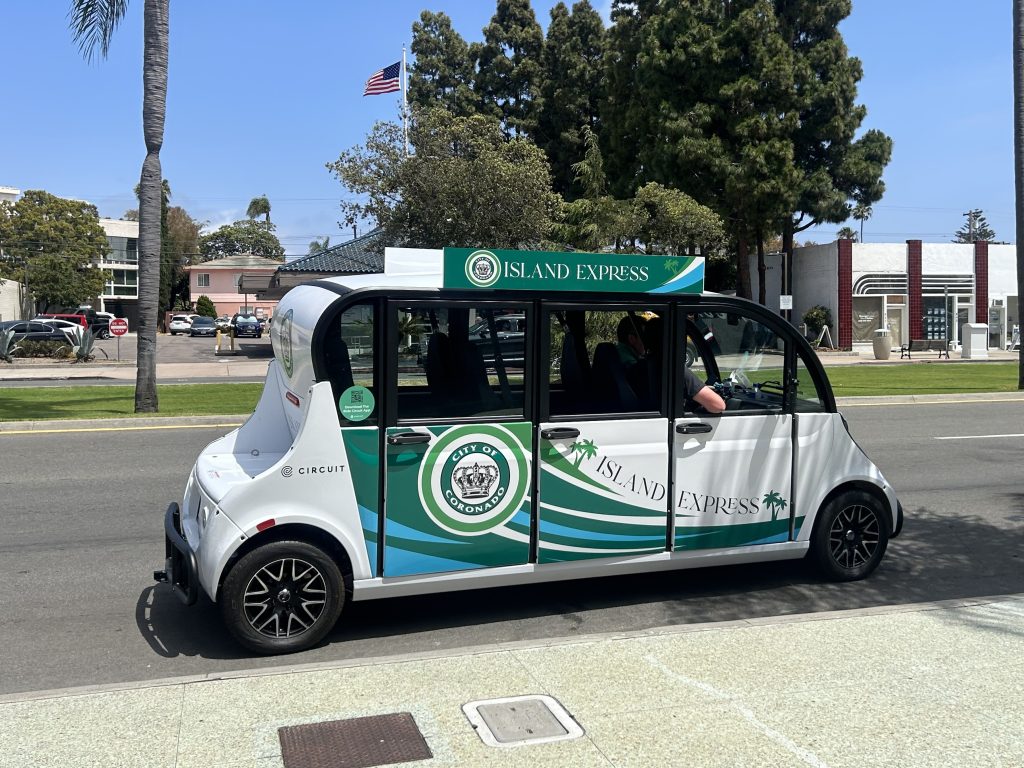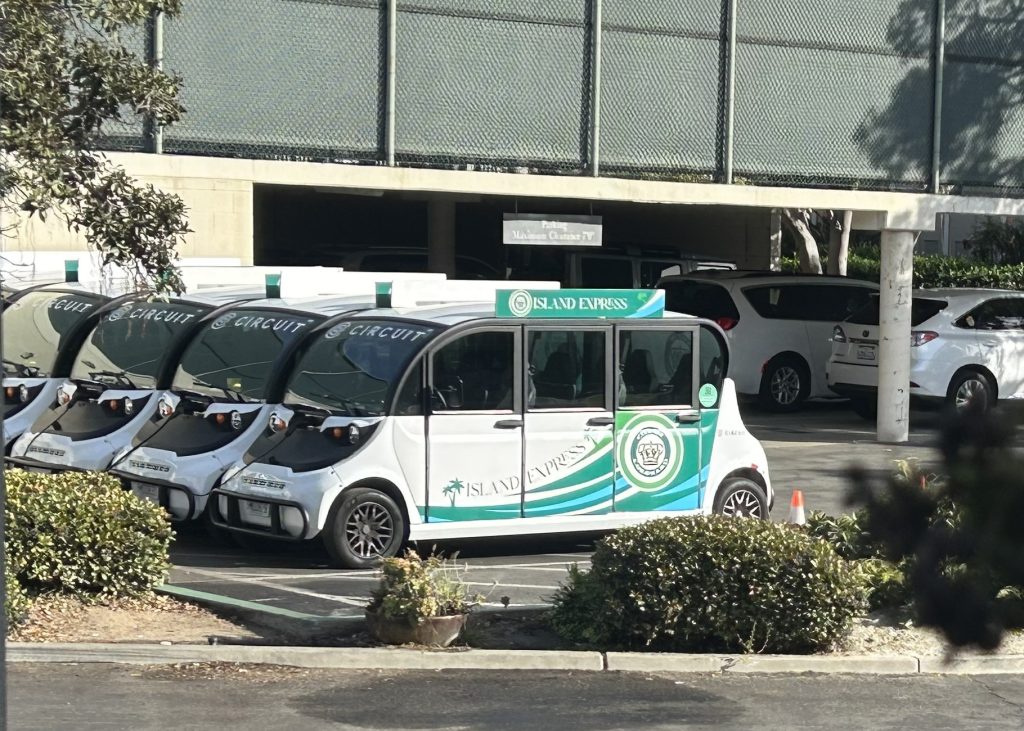
In its first four months of operation, riders have flocked to Coronado’s free, door-to-door electric vehicle shuttle — but it’s an expensive program whose future has yet to be determined.
The Coronado City Council heard an update on the Island Express pilot program’s numbers during an informational presentation at its Nov. 5 meeting. No action was taken, although council members agreed that the cost of the program, as it currently stands, is too expensive to be sustainable.
An average of 322 passengers per day rode the Island Express in those first months, which cost the city just under $87,000 per month. In total, the average cost to the city was $18.43 per ride, or $9.04 per passenger.
Predictably, rides to the Coronado Cays cost more than those in the Village did: The average cost for service to that part of the city was $86.30 per ride, or $48.66 per passenger. There were also much fewer riders, with an average of 16 passengers per day.
By contrast, if considering only rides in the Village, the average cost per ride was $10.06, with a $6.66 cost per passenger.
The six-month pilot will conclude Dec. 4, and it carries a spending cap of $630,000. The program was designed to be as accessible to residents as possible, and in that spirit, rides are free to all passengers during the pilot period.
The idea is that, armed with data from the pilot program regarding demand for a shuttle if there were as few barriers to use as possible, the city could either decide how to make it more sustainable or discontinue it.
In its first four months, 38,366 passengers used the Island Express.
The Island Express pilot program ran alongside the city’s free summer shuttle, whose ridership has not rebounded since the pandemic. Earlier this year, the council said they would give it another year – albeit, with a shortened season – before determining its future.
Ridership on the summer shuttle was up by 53% from last year, but is still substantially lower than pre-pandemic numbers. About 27,000 passengers used the shuttle, which operates on a fixed route, as opposed to the Island Express’ door-to-door service.
The free summer shuttle cost the city $113,398 this year, or $2.03 per passenger. City Council will discuss the summer shuttle’s future in the spring.
Meanwhile, the Island Express, while more utilized, is much costlier. Lessening the cost of the shuttle program could be accomplished many ways: Coronado could compete for grant money; or it could implement a fare sharing model, in which riders would pay part of the cost of their trip and the city would subsidize the rest. The price could be adjusted to charge more for nonresidents.
During the meeting, Coronado Mayor Richard Bailey asked those who spoke in support of the shuttle how much they would be willing to pay. Most answers ranged from $2 to $5 per ride. In a nonscientific survey conducted by the city, 75% of respondents said that they would pay a small fee to use the service.
In another potentially cost-saving approach, Coronado could approach hotels, whose patrons are presumably using the service, to share costs. The city could also sell ads on the shuttles to generate revenue, or it could reduce its hours or geographic scope, either by eliminating the Cays or implementing a fixed route rather than door-to-door service.
The shuttle is operated by Circuit, which also runs multiple other electric shuttle programs in San Diego County. Representatives from the company said at the City Council meeting said that ridership has remained steady as the tourist season has dwindled.
Though the pilot was not without its hiccups, mostly concerning wait times and canceled pick ups, multiple residents during public comment spoke in favor of the program. One said she was able to request a ride to the emergency room after tripping and hurting her ankle, saving her an ambulance trip. As she healed, she used the shuttle to get to and from work.
Another said he and his wife were able to downsize from two cars to one, thanks to the city’s free transit options and bike paths. A third said she met a middle school boy during a recent ride, who said he was one of five children, and the shuttle helped the busy family navigate packed afterschool schedules. He was dropped off to play basketball.
The entire City Council was concerned about the program’s cost, but members agreed that the pilot should conclude before any decisions are made. It wasn’t lost on leaders that they were meeting on Election Day: A new council is imminent. (Latest results in the election are here.)
Coronado Mayor Richard Bailey said the program was too costly and questioned its intent, saying it had no clearly defined goal. Without that, he said, it is hard to evaluate the program’s success.
Much of the conversation around the program’s purpose centers on greenhouse gas emissions. City staff estimated that the shuttle program saved about 5.5 metric tons of greenhouse gas emissions, assuming that 32% of shuttle passengers would have driven a gas-powered car if they hadn’t taken the shuttle. (This number aligns with responses from the city’s survey.)
But Bailey said the cost was too high. He suggested that, if the goal of the program were to reduce emissions, the city could purchase carbon offsets for $25 to $35 per ton.
However, Council Member Carrie Downey said the offsets weren’t a fair comparison, and said a more appropriate one would to be to calculate the cost of adding solar panels to city buildings – an expensive endeavor – and their impact.
Climate isn’t the only potential community benefit of the program, however.
Some hoped the program could alleviate congestion in the city, but there was no measurable change in traffic, Grunow said. In the city’s survey, shuttle riders were asked what mode of transportation they would have used, had the shuttle been unavailable. Only 32% of respondents said they would have driven gas-powered vehicles. Others said they might instead walk or ride their bicycles, which, of course, does not impact the city’s traffic.
Similarly, Grunow said that while a slight improvement on parking congestion was assumed, it was not great enough to measure or even anecdotally notice.
“I think major modifications need to be made in order for this program to continue in any way, shape, or form,” Bailey said, “and I would continue to encourage this council to set clear policy objectives and also some clear benchmarks, so that we can measure success by them.”
The shuttle program directly competes with Coronado Livery, a taxi service.
“It’s hard to compete with something that’s free,” said Carelyn Reynolds, the livery’s president. “And it’s hard to compete when someone is given $600,000 in city funds.”
Reynolds said she would be willing to find ways to work together to deliver a similar service for a potentially lower cost. Donovan said the city should look into this, and should also reach out to rideshare apps to see if the city could enter a contract with them. He also suggested the city compile stronger data about the cost per ton of greenhouse gas emission saved for each of the city’s options to better inform future discussions.
Council Member Casey Tanaka said the data the city is collecting will help the next City Council decide how best to move forward. He said he was alarmed by some of the costs of the program, but he thought the city should conclude its pilot, collecting as much data as possible in the meantime, so an informed decision could be made.
And having data backing the demand for a shuttle service could help Coronado acquire grant funding, said Coronado City Council member John Duncan. Duncan is the city’s representative on the San Diego Association of Governments, which provides transportation grants.
Many cities in the county have implemented similar pilot programs. Some, like San Diego’s Free Ride Everywhere Downtown (FRED) program, still exist. (Riders pay $2.50 to use the shuttle.) Others, like Pacific Beach’s Beach Bug program, is currently out of service, pending a decisions much like Coronado’s into whether it will continue.
“The Circuit programs in other cities were all funded by somebody else’s money,” Downey said, referring to grant money. “And when it came time that it wasn’t somebody else’s money, not all of them continued to do it, because it isn’t necessarily the best use of money or the best way to reduce greenhouse gasses. So I’m back to: ‘All right, why are we doing this?'”






Number one; Too costly Number two; I have personally witnessed blatant traffic violations by the drivers; speeding, crossing double lines and worst was on Orange Avenue heading towards uptown a shuttle driver go from the left lane and cross cut onto Fifth street right in front of another vehicle in heavy traffic!! There is a disaster waiting to happen! Who is vetting these drivers? Dump this pilot program immediate ! Or the cost from and accident is going to be really high!
It’s a fantastic service they hire friendly experienced drivers. I lived in Coronado now San Diego Gaslamp area couldn’t survive without the circuit just a call away.
Because the Coronado Livery is already in existence, why not support our local businesses by letting them explore ways to help our elderly or mobility challenged residents. I’m sure, we can do something better an $86 fare one way from the Cays. Walking and bicycling is the best emissions control option yet, for those who can still do so.
It’s a wonderful thing to know I can have my grandaughter use this service now that darkness comes so early. She’s safe traveling from her friends who live on the other side of the island. I give her the $ to tip the driver each way.
Hi Penny,
Did you read the report? “rides to the Coronado Cays cost more than those in the Village did: The average cost for service to that part of the city was $86.30 per ride, or $48.66 per passenger.”
My friends and I use this service several times a week. It allows us to patronize shops, entertainment, and restaurants on the other side of town without driving and searching for elusive parking. We always tip the very friendly drivers (I have yet to meet a grumpy driver). Many other enlightened, close-by communities offer this service, including Downtown San Diego, Carlsbad, National City, Pacific Beach, and Chula Vista. Some charge a small fee or free to older residents. If we were to charge a fee in Coronado, which I think most would be willing to pay, it would be cheaper AND more reliable than Uber or Lyft—in other words a bargain for all.
Non-residences, staying at local hotels are using this service. While I think residents should pay something, the hotels benefit significantly. I suggest they should be staunch supporters—financially.
Keeping more cars off the streets (and all that entails environmentally), improved access to the Island businesses, support for tourism, and the many costs benefits, make this service a very positive addition for Coronado.
Parking in the Village is over crowded by non residents . Charges should exist for hotel guests and non residents. Children should be transported by parents. Cays residents cannot walk or ride bikes and greatly need this service.